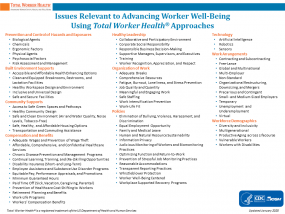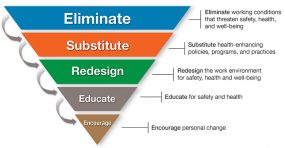Frequently Asked Questions
To learn more about Total Worker Health® , including the program’s history and priorities for the future, find answers to frequently asked questions below.
Total Worker Health Basics
What is Total Worker Health?
The National Institute for Occupational Safety and Health (NIOSH) defines Total Worker Health® (TWH) as policies, programs, and practices that integrate protection from work-related safety and health hazards with promotion of injury and illness prevention efforts to advance worker well-being. The TWH approach always prioritizes a hazard-free work environment that protects the safety and health of all workers. It also brings together all aspects of work in integrated interventions that collectively address worker safety, health, and well-being.
Learn more about what Total Worker Health is and how it benefits workers, employers, and communities.
What is the history behind Total Worker Health?
The Total Worker Health® approach originates from an earlier initiative, Steps to a Healthier US Workforce, and the NIOSH WorkLife program. It was developed by NIOSH and modeled after the US Department of Health and Human Services (HHS) initiative, Steps to a Healthier US. In 2011, NIOSH renamed “WorkLife” to the Total Worker Health® Program, committed to developing knowledge focused on integration of occupational safety and health protection and health promotion.
Discover more about the program’s background, including a timeline of key events, on the History of TWH.

What issues are relevant to Total Worker Health?
The graphic, “Issues Relevant to Advancing Worker Well-Being Using Total Worker Health Approaches” illustrates a wide-ranging list of issues that are relevant to advancing worker safety, health, and well-being. Revised in January 2020, this list reflects an expanded focus for TWH that recognizes workplace and work issues such as innovative technologies, working conditions, and emerging forms of employment that present new risks for today’s and tomorrow’s workforce. Additionally, this expanded focus recognizes that there are linkages between health conditions that may not arise from work but that can be adversely affected by work. Understanding, preventing, and reducing these risks are important elements of TWH.
Learn more about priority areas and emerging issues.
What is the rationale for a Total Worker Health approach?
The TWH approach has benefits for workers, employers, and communities. In recognition of the relationship between work and nonwork conditions, the TWH approach focuses on how the workplace environment can eliminate or reduce risks and enhance overall worker health, going beyond traditional safety and health concerns. Establishing policies, programs, and practices in the workplace that focus on advancing the safety, health, and well-being of the workforce may be helpful for individuals, their families, communities, employers, and the economy as a whole. Employers and organizations from a wide range of industries are taking steps to effectively integrate workplace policies, programs, and practices that protect workers’ safety and health and advance their overall well-being. Promising Practices for TWH highlights real examples of employers and organizations implementing this approach, including the benefits and lessons learned.
Learn more about the evidence base supporting an integrated, holistic approach to worker well-being.
The NIOSH Total Worker Health Program
How does Total Worker Health fit into NIOSH’s mission?
Research shows that integrated approaches are often not used to develop ways to prevent worker illness, injury, and disability. By integrating NIOSH’s traditional focus on factors exclusive to work with attention to health conditions, the cause of which work may be a contributor, TWH seeks to expand our understanding of health and to advance NIOSH’s mission. TWH contributes to NIOSH’s mission to develop new knowledge in the field of occupational safety and health by promoting and fostering research to increase understanding of health conditions that may not arise from work but that can be adversely affected by work. TWH plays an active role in the National Occupational Research Agenda (NORA) through the Healthy Work Design and Well-Being (HWD) Cross-Sector Council. The HWD program aims to protect and advance worker safety, health, and well-being by improving the design of work, management practices, and the physical and psychosocial work environment.
TWH seeks to amplify NIOSH’s mission to transfer knowledge into practice by increasing the number of work environments that adopt evidence based TWH approaches. This is accomplished through focus on five core areas: research program development and collaboration, research translation and communication, partnership development, workforce development, and, internally, through HealthiestNIOSH.
How does the Total Worker Health approach complement the work being done by other Department of Health and Human Services initiatives?
As a part of the Centers for Disease Control and Prevention (CDC) in the U.S. Department of Health and Human Services (HHS), NIOSH is mindful that the integration of occupational safety and health protection with efforts to improve the overall health of American workers by preventing all-cause injury and illness, amplifies the efforts of CDC and HHS to promote Healthy People 2020. Examples of these efforts include the CDC’s Workplace Health Promotion Program and the Surgeon General’s Priorities.
The TWH program routinely collaborates with related CDC, National Institutes of Health, and other HHS programs to ensure that the safety, health, and well-being of workers is considered from the broadest possible perspective—one that addresses occupational safety and health protection and integrates a range of other approaches to prevent injury and illness and advance worker well-being. Partnerships are key to achieving this mission and our partners represent labor, industry, academia, government agencies, non-profit organizations, and more.
Learn more about our partnerships.
Total Worker Health in Practice
What does Total Worker Health look like in practice?
Implementing a TWH approach is an ongoing effort in which workers’ safety, health, and well-being are top priorities. In many settings, TWH consists of a mix of interventions, policy changes, and practices that create a robust culture of safety, worker protection, and greater health opportunity. Putting this approach into action often starts with an organizational focus, assessing challenges to keeping workers safe and healthy, followed by changes to the built environment, policies, and programs. TWH programs are voluntary and participatory, giving workers a voice in the conditions of their work and a say in workplace offerings. Implementation can be incremental and is best driven by worker input using the participatory approach.
The Promising Practices webpage provides real-life examples of organizations that are moving towards a TWH approach. The TWH in Action! eNewsletter features examples from the Centers of Excellence for Total Worker Health and TWH affiliates implementing TWH approaches. The TWH Webinar Series also highlights the latest research and case studies for protecting the safety and health of workers.
Can you provide examples of Total Worker Health policies, programs, and practices?
Employers and workers planning to adopt a TWH approach should consider the use of the Hierarchy of Controls Applied to NIOSH TWH for prioritizing efforts to advance worker safety, health and well-being. The following are some examples of approaches and interventions that could support a robust TWH program in your organization (the items are not ordered by importance or priority).
- Control hazards and exposures
- Design work schedules and patterns to reduce stress and increase worker control
- Build safer, healthier environments
- Provide fair compensation and affordable benefits that enhance health
- Cultivate leaders and values that encourage healthy supervision, respect for workers, and responsible business decisions
- Create policies and environments that are inclusive and accepting of workers’ differences
- Create safety and health interventions that will also have community impact
In addition to resources to assist organizations in getting started, employers and workers can discover real-life examples of organizations that are moving towards a TWH approach in Promising Practices.

What sets the Total Worker Health approach apart from traditional occupational safety and health programs?
Traditional occupational safety and health protection programs have primarily focused on ensuring that work is safe and that workers are protected from the harms that arise from work itself. TWH builds on this approach, recognizing that work is a powerful social determinant of health. The Hierarchy of Controls Applied to NIOSH TWH expands the traditional hierarchy from occupational safety and health to include controls and strategies that more broadly advance worker well-being. Starting at the organizational level and narrowing down to the individual, this hierarchy includes five elements: eliminate, substitute, redesign, educate, and encourage. Unlike traditional occupational safety and health programs, TWH approaches consider the worker health influences that arise outside the workplace, to include interactions between work and non-work demands and circumstances.
What sets the Total Worker Health approach apart from most workplace “wellness” programs?
TWH approaches are not the same as traditional health promotion programs or employee wellness programs in most settings. The TWH approach requires a strong commitment to better working conditions as keeping workers safe is the foundation upon which TWH programs are built. TWH should not be characterized as an add-on “wellness program” that has been implemented without simultaneously providing safe and healthful working conditions. TWH is not a collection of health promotion efforts at a workplace where the very way that work is organized and structured is contributing to worker injuries and illnesses. The TWH approach recommends that employers and workers collaborate to design safe and healthy workplaces that support all workers, regardless of individual or legal differences (e.g., employees versus contractors, temporary workers or contingent workers), in both their professional and personal health goals. TWH programs, however, do often contain elements of health promotion, especially those aimed at optimizing the well-being of workers though improved environmental and social supports.
Where can I find more information about research related to Total Worker Health?
The NIOSH TWH program works to advance the safety, health, and well-being of workers by increasing the number of work environments that adopt evidence based TWH approaches. This is accomplished through both intramural and extramural research programs that effectively advance etiologic, surveillance, and intervention research. As a result, this builds the evidence base for an integrated, holistic approach to worker well-being. Learn more about the TWH research program.
How can I or my organization connect with the Total Worker Health Program?
We encourage you to connect with the NIOSH TWH Program by following us on Twitter (@NIOSH_TWH) and subscribing to our e-Newsletter, TWH in Action!
If your organization is interested in becoming a NIOSH TWH affiliate, please visit the NIOSH TWH Affiliate Program page to learn more about this program that bridges partnerships between NIOSH and public and not-for-profit organizations.
Still have questions? Learn more about how to connect with us on our Contact Us page.

